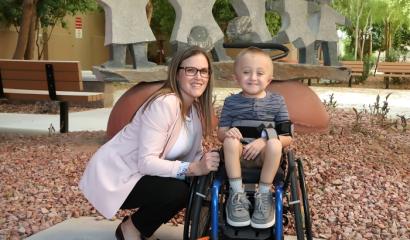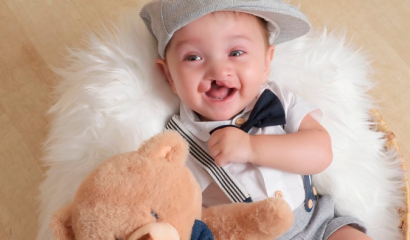Bright Futures
Articles and Updates from Phoenix Children's
Easton has always loved playing sports, especially basketball. But his life changed on Jan. 22, 2023, following a horrible accident while riding a motorized dirt bike. The crash left him with multiple life-threatening injuries, including traumatic brain injury (TBI) and spinal cord injury (SCI) with paraplegia – paralysis of the legs.
Despite the many challenges he’s faced on the journey to healing, the 9-year-old amazes his family, friends and caregivers with his positive spirit and determination.
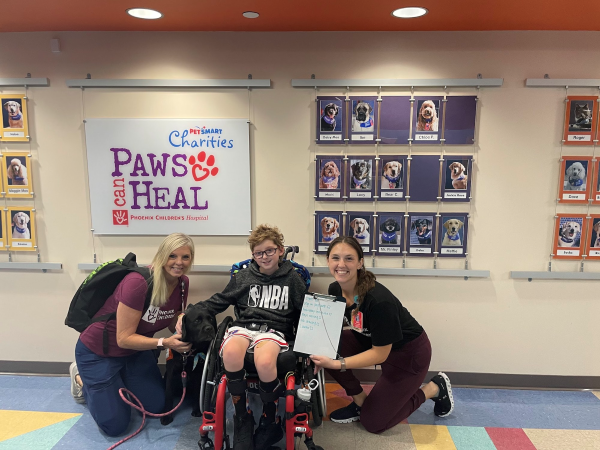
High-impact collision
During a ride on his motorized dirt bike at a local park, Easton crashed head-on into a brick wall at about 30 mph. The collision’s impact caused his helmet – equipped with a facemask – to break in half.
Easton was rushed by ambulance to Phoenix Children’s, where the team at the Center for Trauma Care went to work to save his life. The center is the only American College of Surgeons (ACS)-verified Level I Pediatric Trauma Center in Arizona.
Once Megan and her husband, Bryan, arrived at Phoenix Children’s, a social worker let them know that Easton was unconscious in the trauma room.
“It was definitely a shock to walk into that room, and we were grateful the social worker tried to prepare us,” Bryan said. “Easton was in pretty rough shape.”
The family felt helpless.
“I just sang to him, and we were just praying in our heads the whole time,” Megan said. “I just hoped he would not feel alone.”
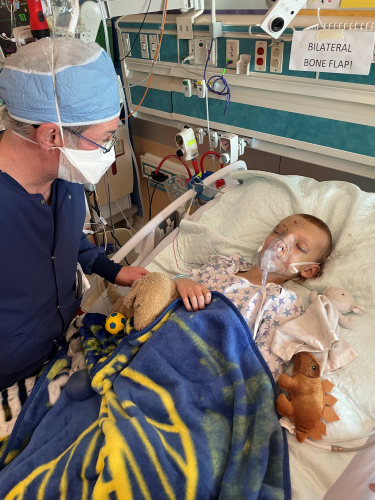
High-level care
The doctors’ immediate concern was brain swelling, which could cause further damage if left unchecked. A day after the accident, Easton was taken into surgery, where neurosurgeon David H. Shafron, MD, performed a bifrontal craniectomy – removing a portion of the skull – and a pericranial graft reconstruction of a skull base defect.
Although Easton and his family were in troubling and unfamiliar territory, his care was in good hands. Dr. Shafron is part of the team at Barrow Neurological Institute at Phoenix Children’s, a multispecialty, patient-centered leader in pediatric neurosurgery and neurological care. Their team focuses on meeting the complex care needs of children with brain, spine and nervous system disorders.
TBI is a leading cause of injury and death among children, affecting over 500,000 American children and hospitalizing over 60,000 kids each year. The lifelong effects of TBI require sophisticated management through every phase of care.
Barrow at Phoenix Children’s provides advanced and integrated services for TBI and other neurological conditions. Doctors and scientists from different fields combine their expertise in medicine, surgery, research, education and supportive services. Their strategic thinking and innovative approaches lead to exceptional outcomes. This high level of coordinated care offers hope and healing for patients like Easton.
From stillness to thumbs up
Once Easton was stabilized, he was admitted to Phoenix Children’s Pediatric Intensive Care Unit (PICU), where he stayed for almost two weeks. Easton celebrated his 9th birthday there, serenaded with “Happy Birthday” by one of his neurosurgeons.
In addition to TBI, Easton suffered a wide range of injuries, including SCI resulting in paraplegia, subdural hematoma (bleeding on the brain), fracture of his right femur, multiple facial fractures, as well as vision loss in his left eye. During the first two weeks at Phoenix Children’s, Easton underwent numerous surgeries, including facial reconstruction, spinal fusion and insertion of a feeding tube.
Easton remained unconscious for approximately 10 days. Magnetic resonance imaging (MRI) revealed that Easton’s brain injury wasn’t as extensive as doctors thought initially. Since Easton began showing positive signs of brain activity, the medical team soon took out his breathing tube and began weaning him off medications.
“The neurosurgery team would ask him to squeeze their hands, and as time went on, he gave some signs that he was hearing them,” Bryan said. “One day, a doctor asked Easton to give them a thumbs up. Easton didn’t respond. The doctor repeated loudly, ‘Easton, give me a thumbs up.’ And Easton shot both of his thumbs up in the air. That was such a relief for us.”
Recovery begins
By mid-February, Easton was admitted to inpatient rehabilitation, where he worked with physical and occupational therapists and board-certified pediatric physiatrists. They taught him how to use a wheelchair, how to move from bed to wheelchair with help from his parents, and how to dress and bathe, also with his parents’ help.
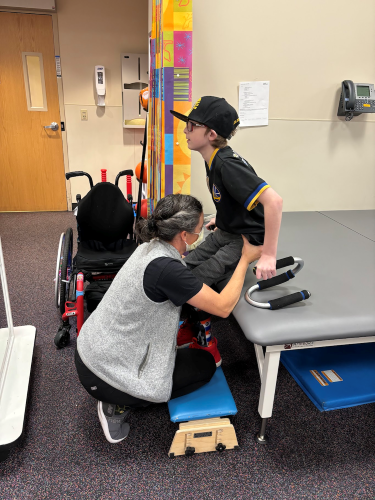
TBI patients without SCI typically need to relearn skills they once knew well, such as walking or talking. Easton’s dual diagnosis of TBI and SCI made recovery more difficult. For example, he struggled with wakefulness, slow processing speed and lack of motivation due to his brain injury. At the same time, Easton needed to learn new skills (wheelchair use, mobility with only the use of arms) for the first time. Because of his injured brain, it was difficult for Easton to comprehend things in the same way that he previously did. The rehab team worked together cohesively to tackle both the cognitive effects and physical limitations from his injuries.
Emotionally and psychologically, it was challenging for Easton to cope with both TBI and SCI. He worked with a trauma counselor to help him cope with the accident. He also found comfort in visits with the hospital’s therapy dogs, especially Checkers.
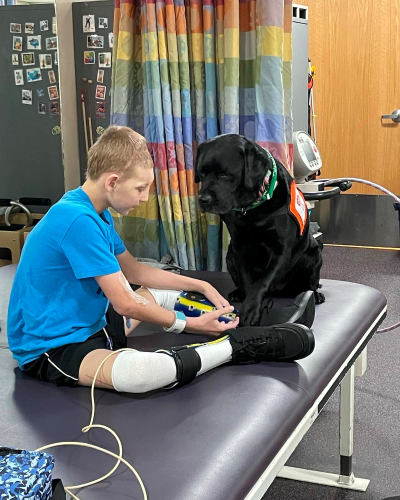
Sports therapy
Before the accident, Easton was an active kid who loved sports, such as kickball, hockey, baseball and basketball. “His favorite times during school were physical education and recess,” Bryan said.
“Our initial reaction to finding out about his injuries was that this was going to be awful for him – it’s the end for so many of the things he loves,” Bryan said. “But these life-changing injuries have not stopped him at all. He’s had a positive attitude and hasn’t complained.”
Easton’s rehab team has helped him find new activities to participate in. Wanting to help him reconnect with basketball – one of his favorite sports – they took him to Ability360, a center for independent living in Phoenix, to teach him how to play basketball from a wheelchair. The outing improved his mood and motivation, and it gave him a fun goal to work toward.
“Easton was hooked,” said Bryan, adding that Easton played for Ability360’s summer league and is continuing with the sport.
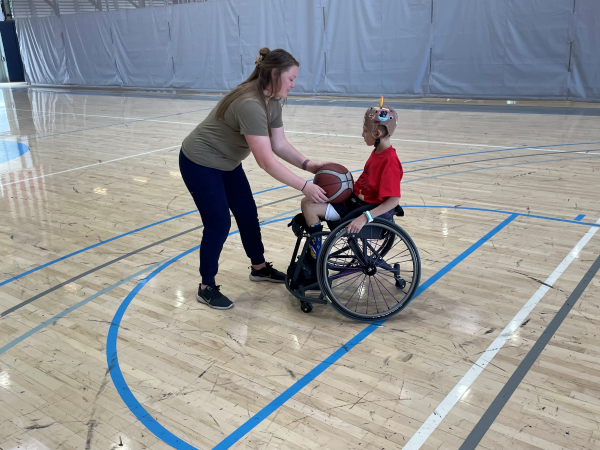
New ways of living
Easton’s injuries meant developing new routines and adapting to new realities. His family credits the Phoenix Children’s care team and his providers at Barrow Neurological Institute at Phoenix Children’s for helping them adjust.
“Easton was in inpatient rehab for about a month, and the care team was great at showing us what they were doing and explaining it to us,” Bryan said. “As we got closer to Easton’s discharge date, it was more hands-on, as they let us try to do things for him. We felt as prepared as we could be when we went home. Certainly, it was still scary, and the first couple of days were pretty intense, but the team at Phoenix Children’s definitely gave us all of the tools and preparation we needed.”
The child life team at Phoenix Children’s also worked closely with Easton’s younger sister, Hadlie, to help her understand his injuries and cope with time away from her parents. They even gave Hadlie a stuffed lion wearing all the same tubes and bandages Easton was wearing.
Easton continues working with the rehab team on an outpatient basis and loves going to these appointments. They help him with functions such as memory recall, mental math and improving upper body strength.
Easton remains positive and is determined to help others coping with traumatic injuries.
“Easton has been brave, and he has inspired others,” said his mother, Megan. “What Easton has gone through has been very difficult, but he has never given up. He is determined to help others who are going through similar experiences.”
